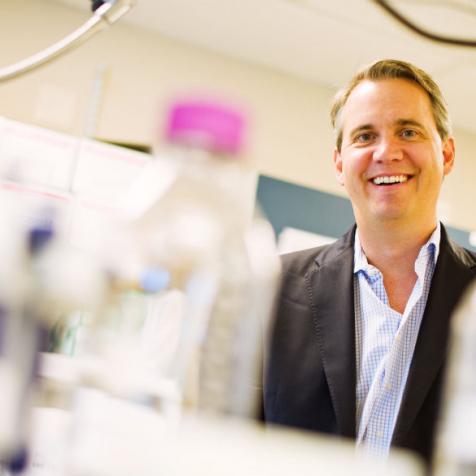
Company Details
Location
Aurora
Founded
2007
Ownership Type
Private
Employees
14 in Colorado. 6 contractors in Illinois
Products
Advanced Material technology
Aurora, Colorado
Founded: Licensed From the University of Florida in 2007
Ownership: Private, venture capital financed
Employees: 14 in Colorado. 6 contractors in Illinois
Sharkskin-like texture is proving a formidable foe to bacteria in applications as varied as medical devices and iPhone cases for Mark Spieckers’ growth-minded company.
A bacteria thwarting, shark inspired iPhone case might sound appealing to parents with ice cream and chocolate smeared iPhones but that’s just a foot in the door for second-stage Sharklet Technologies. The company, which moved to Aurora’s Anschutz Medical Campus from Florida in 2010, uses the unique properties of shark’s skin as an inspiration to reduce bacteria-related infections in medical devices.
Really? From medical devices to iPhone cases? “There’s a significant market for iPhone cases,” explains Sharklet CEO Mark Spiecker. “Everybody knows what an iPhone case is, and when I walk into a meeting and show him or her our technology it’s a very tangible thing,” he says. He shows the data on how the case repels bacteria based on Sharklet’s patented technologies. Hence a company focused on medical devices and planning to debut its first products this year is starting out with an iPhone case under $30.

The company’s first medical product is a Foley catheter co-developed with Cook Medical. “Our goal is to get that catheter through all the medical device design processes, get regulatory approval and through regulatory trials in the next six months,” Spiecker says. But he envisions incorporating the design into various films and other applications, including food packaging.
The problem the company is addressing is huge. “In the U.S. about 2 million people a year get infections in a hospital. Those are infections they didn’t come in the door with. We spend about $30 billion a year treating those infections and despite those efforts about 100,000 people die,” Spiecker asserts.
“A bacteria lives for about 18 minutes and…If it doesn’t attach within that time it kind of dies and doesn’t replicate,” says Spiecker. If it does attach other organisms will join it, which can cause infections in humans, making them sick. “We believe if we can keep the attachment from occurring we can keep the biofilms and the big nasty bacteria globs from growing.”

“We don’t use antibiotics, we don’t use heavy metals. It’s really just the texture and the shape of the surface that microorganisms find inhospitable,” Spiecker says of Sharklet’s technology. The sharkskin inspired texture resembles a diamond pattern but at 3 microns tall and 2 microns wide. “We’re talking about a 1/50th the size of the human hair.”
Spiecker explains that the company was founded when they licensed the technology from the University of Florida in 2007. “In the mid- to late-2000s our professor at the University of Florida, Dr. Anthony Brennan, was working on this idea of engineered roughness.” He realized that sharks, though not fast movers, didn’t get barnacles like turtles, whales and manatees. “After quite a bit of research he realized it had something to do with the shape of their skin. Particularly the physical texture.”
The company’s raised about $5.1 million in venture capital and angel funding and another $5 million in grant funding—much from National Institute of Health SBIR (Small Business Innovation and Research) grants. As the company moves toward commercialization it’s looking to raise $10 million over the next year, according to Spiecker.
“There are very few technologies using features in this size that are in any kind of at-work capacity,” Spiecker notes. “That’s really the big challenge that we faced in manufacturing over the last seven years.”

That’s changing. Sharklet partnered with a Chicago company to make molds that mimic or replicate its structures on flat and three-dimensional surfaces using an injection molding process, Spiecker explains. He adds that the technologies are based in automotive taillights and LED lighting.
Challenges: Testing. “All of the standard tests…are all kill-based tests. They all measure the effectiveness of the surface to elute a chemical off of it and to be able to kill the microorganisms. We’re the first tech that’s come out that says killing isn’t the right way. We think killing has helped the bacteria adapt to become resistant to antibiotics,” Spiecker says.
Opportunities: The medical device sector and building academic credibility to show it prevents attachment.
Needs: “We need money to invest in our manufacturing resources so we start manufacturing at scale. That and running clinical trials to validate the technology in the human environment,” Spiecker says.

